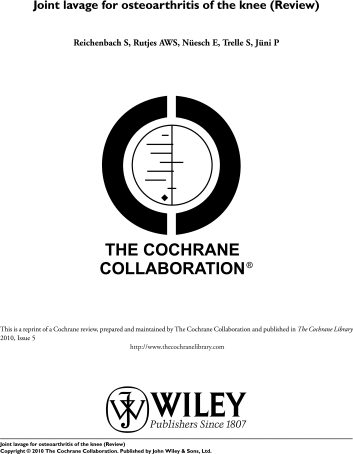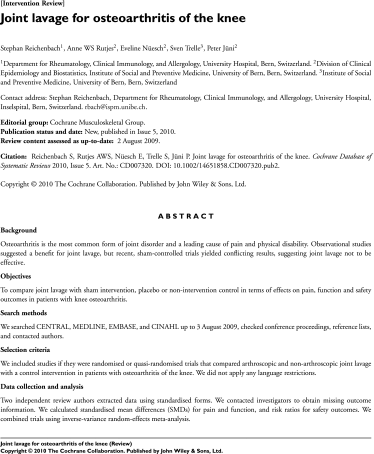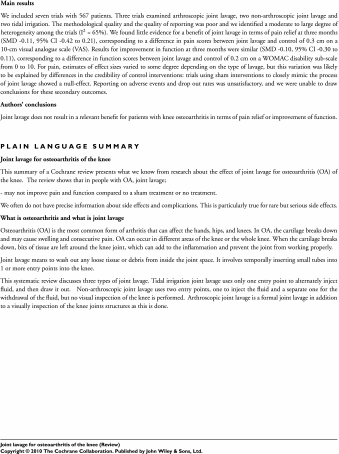Importance of the Topic
Osteoarthritis of the knee is a progressive and debilitating condition that affects more than 9.2 million individuals in the United States [4]. The socioeconomic impact of this condition is substantial as well, resulting in billions of dollars in health-related expenditures and indirect economic losses [2, 3, 5]. Management options for knee osteoarthritis range from nonsurgical (or “conservative”) measures such as physiotherapy and pharmacologic therapy, to surgical interventions such as joint lavage, arthroscopic débridement, and ultimately partial or TKA. Ensuring that interventions offered to patients are evidence-based is an important strategy to help direct finite healthcare resources only towards those interventions that are effective.
Joint lavage used alone, either with or without arthroscopy (and without débridement), has been proposed as a possible temporizing intervention, which may improve pain and function in the short-term and delay knee arthroplasty. Theoretically, joint lavage may “wash out” microscopic and macroscopic intraarticular debris, as well as inflammatory cytokines, all of which potentially contribute to synovitis and pain [1, 6, 8]. Whether there is high quality evidence to support this theoretical benefit was the subject of this systematic review [7].
Upon Closer Inspection
Reichenbach and colleagues [7] performed a thorough and rigorous systematic review of both randomized and quasi-randomized trials gathered from multiple databases and manual searches of both published and unpublished studies. However, the results should be interpreted with an understanding of the methodological limitations of included trials.
Among the seven included trials, there was substantial variability in the types and characteristics of both interventions and controls. Allocation sequence generation was appropriate in only two of the seven included trials, and allocation was adequately concealed in only three studies. Only two studies analyzed data using the intention-to-treat principle.
Outcome data showed no overall benefit to treatment, although there was a high degree of heterogeneity among trials. Therefore, these trials likely overestimated any actual treatment effect. Researchers found no improvements in pain at 1 year or function at 3 months or 1 year. Among the three trials that reported function at 1 year, a possible treatment benefit was suggested by the homogeneity of the results; however, the effect sizes were very small and likely not clinically important.
Take-Home Messages
Overall, there is no conclusive evidence that joint lavage improves either pain or function at 3 months or 1 year for osteoarthritis of the knee. Available clinical trials are small in size, few in number, poor in quality, and heterogeneous in methodology and outcomes. If strong clinical equipoise continues to exist among orthopaedic surgeons, large randomized controlled trials with rigorous methodology, including reasonable attempts at blinding, will be necessary. Owing to the lack of benefit demonstrated in this systematic review of available trials, alongside a lack of strong clinical equipoise, joint lavage alone is not recommended as a routine intervention in the management of osteoarthritis of the knee.
Appendix



Footnotes
A Note from the Editor-in-Chief: I am pleased to announce the partnership between CORR®, The Cochrane Collaboration® , and McMaster University’s Evidence-Based Orthopaedics Group for a new column, called Cochrane in CORR®. In it, we will identify an abstract originally published in The Cochrane Library that we think is especially important, and Dr. Mohit Bhandari, our Deputy Editor for Evidence-Based Orthopaedics, and his colleagues from McMaster University will provide expert perspective on it.
The author certifies that he, or a member of his immediate family, has no funding or commercial associations (eg, consultancies, stock ownership, equity interest, patent/licensing arrangements, etc.) that might pose a conflict of interest in connection with the submitted article.
All ICMJE Conflict of Interest Forms for authors and Clinical Orthopaedics and Related Research ® editors and board members are on file with the publication and can be viewed on request.
The opinions expressed are those of the writers, and do not reflect the opinion or policy of CORR ® or the Association of Bone and Joint Surgeons®.
Cochrane Reviews are regularly updated as new evidence emerges and in response to feedback, and The Cochrane Library (http://www.thecochranelibrary.com) should be consulted for the most recent version of the review.
This Cochrane in CORR® column refers to the abstract available at: DOI: 10.1002/14651858.CD007320.pub2.).
(Reichenbach S, Rutjes AW, Nüesch E, Trelle S, Jüni P. Joint lavage for osteoarthritis of the knee. Cochrane Database Syst Rev. 2010 May 12;(5):CD007320. doi: 10.1002/14651858.CD007320.pub2. Copyright © 2010 The Cochrane Collaboration. Published by John Wiley & Sons, Ltd. Reproduced with permission.)
Contributor Information
Harman Chaudhry, Email: harman.chaudhry@medportal.ca.
Mohit Bhandari, Email: bhandam@mcmaster.ca.
References
- 1.Bernstein J, Quach T. Questioning the value of arthroscopic knee surgery for osteoarthritis. Cleve Clin J Med. 2003;70:401–410. doi: 10.3949/ccjm.70.5.401. [DOI] [PubMed] [Google Scholar]
- 2.Gupta S, Hawker GC, Laporte A, Croxford R, Coyte PC. The economic burden of disabling hip and knee osteoarthritis from the perspective of individuals living with this condition. Rheumatology (Oxford). 2005;44:1531–1537. doi: 10.1093/rheumatology/kei049. [DOI] [PubMed] [Google Scholar]
- 3.Kim S. Changes in surgical loads and economic burden of hip and knee replacements in the US: 1997-2004. Arthritis Rheum. 2008;59:481–488. doi: 10.1002/art.23525. [DOI] [PubMed] [Google Scholar]
- 4.Lawrence RC, Felson DT, Helmick CG, Arnold LM, Choi H, Deyo RA, Gabriel S, Hirsch R, Hochberg MC, Hunder GG, Jordan JM, Katz JN, Kremers HM, Wolfe F. National Arthritis Data Workgroup. Estimates of prevalence of arthritis and other rheumatic conditions in the United States: Part II. Arthritis Rheum. 2008;58:26–35. doi: 10.1002/art.23176. [DOI] [PMC free article] [PubMed] [Google Scholar]
- 5.Murphy L, Helmick CG. The impact of osteoarthritis in the United States: a population-health perspective. Am J Nurs. 2012;112:S13–S19. doi: 10.1097/01.NAJ.0000412646.80054.21. [DOI] [PubMed] [Google Scholar]
- 6.Popert J. Rice-bodies, synovial debris, and joint lavage. Br J Rheumatol. 1985;24:1–5. doi: 10.1093/rheumatology/24.1.1. [DOI] [PubMed] [Google Scholar]
- 7.Reichenbach S, Rutjes AWS, Nüesch E, Trelle S, Jüni P. Joint lavage for osteoarthritis of the knee. Cochrane Database of Systematic Reviews. 2010 doi: 10.1002/14651858.CD007320.pub2. [DOI] [PubMed] [Google Scholar]
- 8.Weitoft T, Uddenfeldt P. Importance of synovial fluid aspiration when injecting intra-articular corticosteroids. Ann Rheum Dis. 2000;59:233–235. doi: 10.1136/ard.59.3.233. [DOI] [PMC free article] [PubMed] [Google Scholar]


